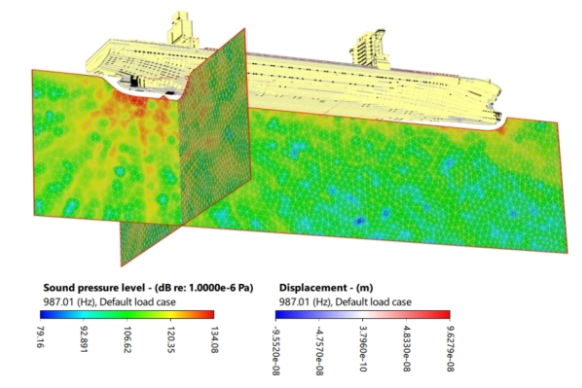Samsung Heavy Industries captures ship's underwater noise
The company plans to advance its noise abatement tech to protect marine ecosystems and respond to relevant regulations
By Jul 11, 2023 (Gmt+09:00)
LG Chem to sell water filter business to Glenwood PE for $692 million


Kyobo Life poised to buy Japan’s SBI Group-owned savings bank


KT&G eyes overseas M&A after rejecting activist fund's offer


StockX in merger talks with Naver’s online reseller Kream


Mirae Asset to be named Korea Post’s core real estate fund operator



South Korean shipbuilder Samsung Heavy Industries revealed on Tuesday that it has attained cutting-edge technology enabling the precise analysis of underwater radiated noise through the examination of sound waves detected by sonar.
The utilization of sonar signal analysis technology permits the measurement of the noise intensity, direction, and distance emitted by various noise sources. Primarily deployed in military operations for ship detection purposes, this technology has now found its application in the field of underwater radiated noise research.
Samsung Heavy Industries accomplished a significant milestone by becoming the first to implement this technique in the study of underwater ship noise in commercial vessels. Notably, they successfully analyzed the noise source of an exceptionally large 174,000 cubic meter-class liquefied natural gas (LNG) carrier.
Underwater ship radiated noise emanates from the cavitation of propellers, the ship's structure, and its machinery during navigation, potentially causing direct repercussions on marine ecosystems, including marine mammals and fish.
In response to the growing significance of regulating underwater radiated noise, discussions led by the International Maritime Organization are currently in progress. Consequently, the development of noise reduction technologies has gained substantial importance.
Samsung Heavy Industries elucidated that their newly acquired technology will enhance their competence in related technological advancements.
They will be capable of analyzing the causes and impacts of underwater radiated noise, subdividing noise sources in dry-docked vessels, and predicting noise levels based on variables such as speed and draft (the depth at which the hull is submerged in water).
Write to Jae-Fu Kim at fu@hankyung.com
-
 Shipping & ShipbuildingSamsung Heavy Industries succeeds autonomous vessel navigation
Shipping & ShipbuildingSamsung Heavy Industries succeeds autonomous vessel navigationJul 06, 2023 (Gmt+09:00)
1 Min read -
 Shipping & ShipbuildingSamsung Heavy to establish R&D center in Busan
Shipping & ShipbuildingSamsung Heavy to establish R&D center in BusanJun 12, 2023 (Gmt+09:00)
1 Min read -
 Shipping & ShipbuildingSamsung Heavy starts to construct ammonia test facility
Shipping & ShipbuildingSamsung Heavy starts to construct ammonia test facilityJun 01, 2023 (Gmt+09:00)
1 Min read -
 Shipping & ShipbuildingSamsung Heavy Industries develops next-generation FLNG
Shipping & ShipbuildingSamsung Heavy Industries develops next-generation FLNGMay 02, 2023 (Gmt+09:00)
1 Min read -
 EnergySamsung Heavy forms int'l consortium to make nuclear plants at sea
EnergySamsung Heavy forms int'l consortium to make nuclear plants at seaApr 21, 2023 (Gmt+09:00)
1 Min read -
 Shipping & ShipbuildingSamsung Heavy partners with Kongsberg Maritime for autonomous ships
Shipping & ShipbuildingSamsung Heavy partners with Kongsberg Maritime for autonomous shipsMar 20, 2023 (Gmt+09:00)
1 Min read


